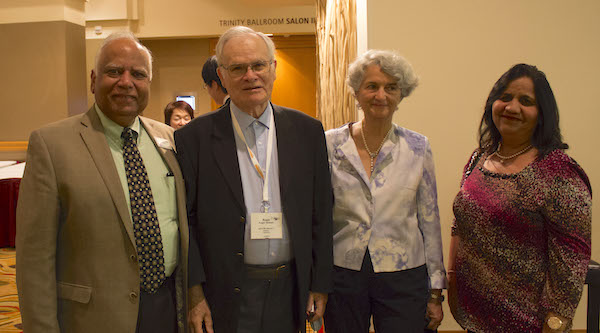
[Image above] From left: Mrityunjay Singh, Roger Naslain, Dominique Naslain, and Gita Singh. Credit: ACerS
Student report by Michael Presby, The University of Akron
The second day of the 9th International Conference on High Temperature Ceramic Matrix Composites began with technical presentations from multiple experts in the field of ceramic matrix composites (CMCs). One such presentation was given by Honorary Professor Roger Naslain from the University of Bordeaux who took us on “a journey in the field of ceramic matrix composites.” Professor Naslain is regarded as one of the leaders in the field of composite materials where he created (1998) and directed (1998-2001) the Laboratory for Thermostructural Composites (LCTS). The primary research focus at the LCTS is on ceramic fibers, processing methods, fiber-matrix interphase/interface, and mechanical behavior.
Professor Naslain’s presentation highlighted five key steps in the field of ceramic matrix composites (CMCs) that were significant milestones in the development and optimization of CMCs and their properties. The key steps highlighted during his presentation were the development of the CVI process (1975-1980), the extension of I-CVI (1980-1990), the development of the interphase concept (1990-1995), the concept of the multilayered interphase (1993-1998), and the concept of the self-healing matrix (1999). Each one of these steps was integral in furthering the development of CMCs to the point at which they are today.
Although an early morning presentation, Professor Naslain drew a large audience and filled every seat in the ballroom. In fact, many individuals were found standing in the back of the room in order to get the chance to hear and learn from such an influential scientist who has contributed so much to the scientific and CMCs communities. The audience consisted not only of students and young professionals, but also researchers who have already made significant contributions in the field of CMCs. Professor Naslain’s presentation was very well balanced. It provided a great overview of the field of CMCs for students and young professionals, but it also went into enough depth to provide novel information for the senior level researcher.
I am currently a first year Ph.D. student in Mechanical Engineering at the University of Akron working under Dr. Gregory Morscher. My research focus is in the area of testing high-temperature CMCs and utilizing non-destructive evaluation techniques to assess and monitor damage. It was an honor to be able to attend Professor Naslain’s presentation and learn from such an accomplished individual who has contributed so much of his knowledge to the CMCs community. I was able to take a lot of valuable knowledge away from his presentation that will further my understanding of CMCs, and I will be able to carry over this understanding into my own research. In addition, it was great to be provided the opportunity to sit among other respected researchers in the field in order to listen and learn from their comments and questions. Students and young professionals in attendance at HTCMC-9 are presented with a great chance to learn from and interact with many of the leaders in the field of CMCs.
Lastly, as a recipient of the National Science Foundation travel award, I would like to express gratitude to Dr. Surojit Gupta and the National Science Foundation for selecting and providing me travel support so I could attend this conference.
